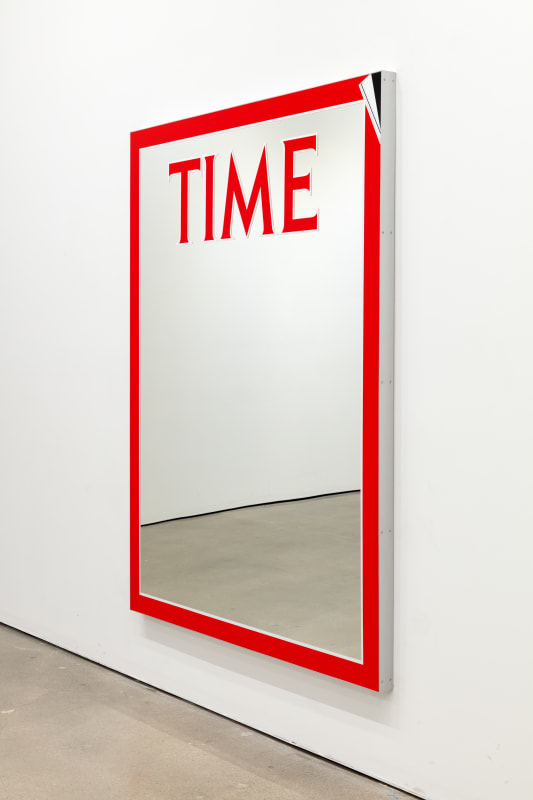I often ponder what the window-gazer thinks when they pass by a gallery. For those who peer curiously through the window, momentarily stalled by the pretty pictures, the current exhibition at Rebecca Camacho Presents must be a head-scratcher.
Standing tall and isolated, not unlike a stone head on Easter Island or hedge in SE England, Fiona Connor’s Closed Down Clubs, Club Tee Gee LA greets both the viewer and the window-gazer, situated in the front center of the gallery, defiantly blocking any hopes of a wide view of the space. An exact replica of a door seen during Connor’s wandering around a changing Los Angeles, Closed Down Clubs, Club Tee Gee LA pays homage to a building and time otherwise lost to memory. Presented without hinges, the sculpture contemplates the way material objects ground our memories.
To Connor’s right, SoiL Thornton’s, Labor Cont(r)act (assisted), is installed on the wall, the erratically spray painted and passing a column. A la Sol Lewitt, the piece entails instructions that direct the preparator to spray paint the artist’s phone number in a certain way. The phone number functions as an invitation to discuss, question, or merely say hello, should the viewer choose to interact.
Bordering Connor’s door to the left are two mirrored pieces, Mungo Thomson’s Time Magazine cover July 23 1984 (Geraldine Ferraro A Historic Choice), and Davina Semo’s polished bronze Falling. The two pieces use the interactive nature of the reflective surface in their own way, each somewhat reliant on the image of the viewer to complete the piece. Whereas Thomson’s piece invites the viewer to reenact a pivotal moment in political history and reflects the viewer in accurate verisimilitude, Semo’s inclusion is much more subtle. A mostly flat surface, tarnished by hand-turned drill bits is polished to the point of reflectivity. As much as a viewer may try to view the artwork on its own, head-on, their own reflection is inescapably included.
In Vernon Price’s photograph Shimbaree Shimbarah, a model gazes at the viewer. Despite reclining in a position reminiscent of a Matisse or Ingres nude, the model poses behind three stacked Plia chairs. These chairs splice the model’s face, and genitals, simultaneously diverting and drawing the viewer’s attention to the model’s transgender identity. The piece questions convention - the notion of a chair as an exclusively functional object sets the stage for a fuller examination of binary assumptions regarding gender. Framed with an acrylic molding, the inner workings of the physical piece are on display, unmasked and unconcealed.
Linder writes on his curating: “The artists participating in the exhibition create challenging artworks that reveal a fascination with time, space, architecture, identity, and perceptual phenomena in general.” Each of the six artworks features a form of beckoning - be it the opening of a door, the reflection of a familiar face, or the intrigue of the unfamiliar. While manifested in myriad ways, the allure of each is rooted in a sense of nostalgia or wonder. While Thomson and Connor’s works seek to preserve history, Semo and Vernon Price’s photography raises pertinent questions about our perception of identity. As the window gazer or gallery-goer, the six artworks invite the viewer to engage beyond the surface, and in doing so embrace the simultaneous then and now.
Luc Sokolsky







